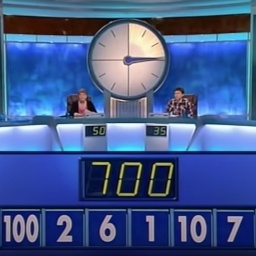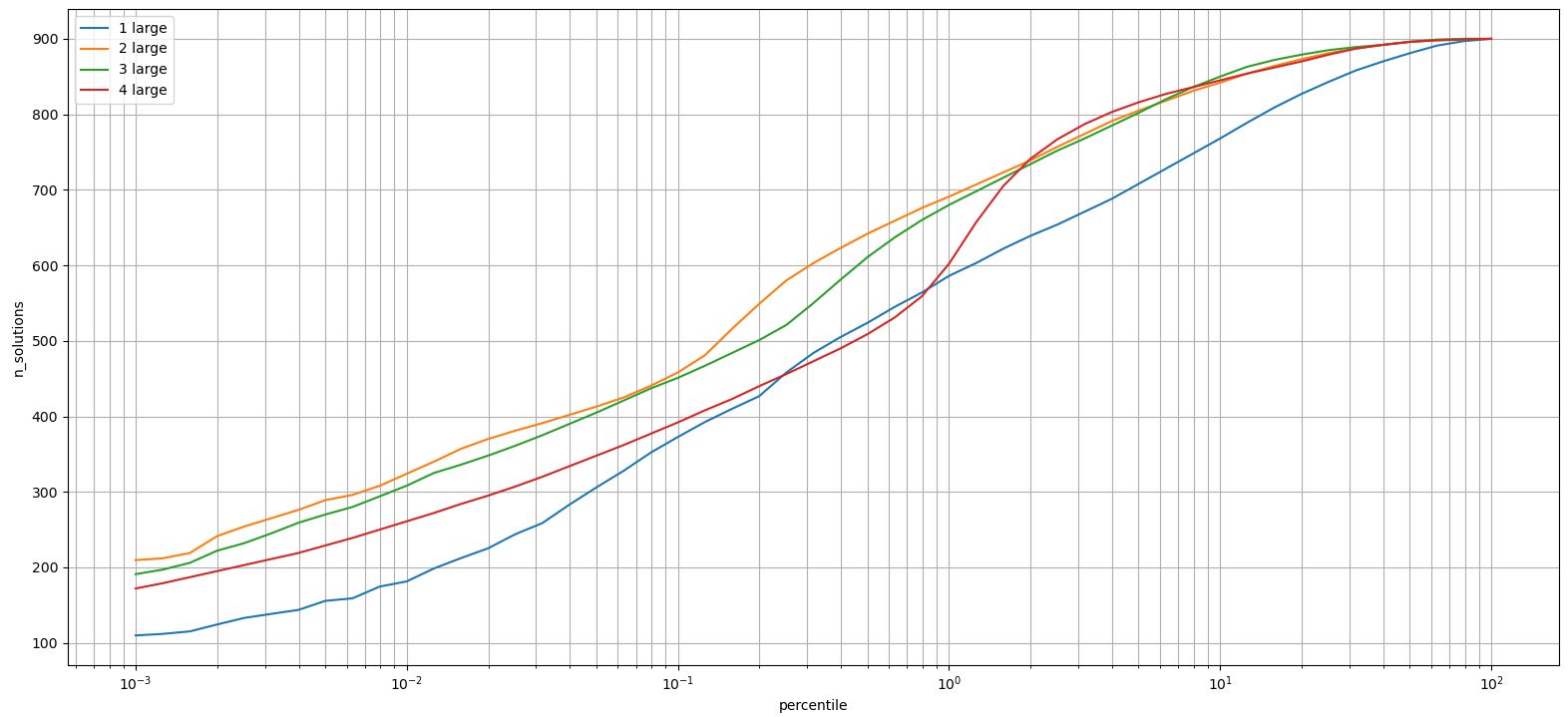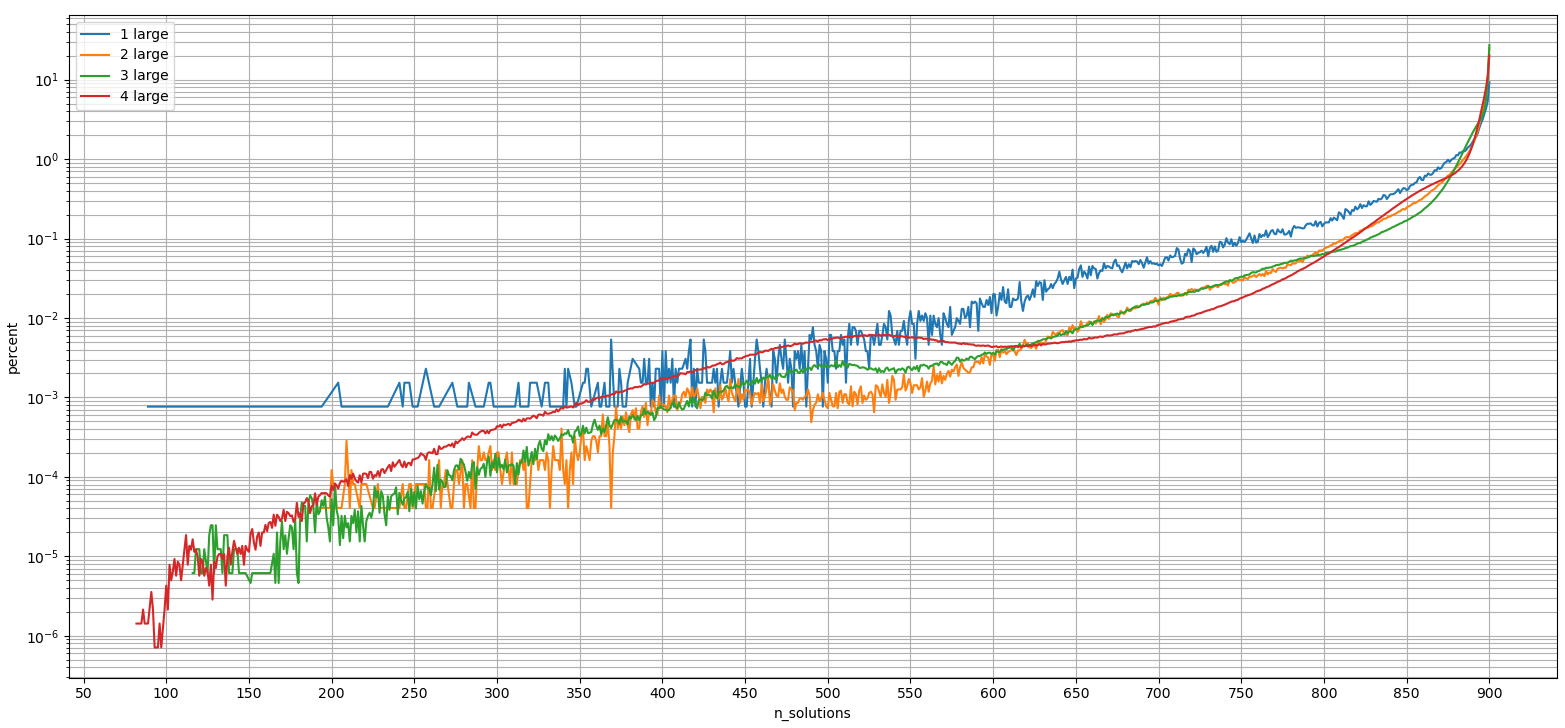Youtuber Another Roof posed an interesting question on his video "The Surprising Maths of Britain's Oldest* Game Show". The challenge was stated in the video's description: "I want to see a list of the percentage of solvable games for ALL options of large numbers. Like I did for the 15 options of the form {n, n+25, n+50, n+75}, but for all of them. The options for large numbers should be four distinct numbers in the range from 11 to 100. As I said there are 2555190 such options so this will require a clever bit of code, but I think it’s possible!". His reference Python implementation would have taken 1055 days (25000 hours) of CPU time (when all four large numbers are used in the game), but with CUDA and a RTX 4080 card it could be solved in just 0.8 hours, or 31000x faster!
Although, there is some confusion since he says that his code took 90 minutes to run per chosen four digits, but on my experiments with i7-6700K CPU and without any multiprocessing I measured it to take about 0.65 seconds per a "game" (a set of six numbers). When whe choose the remaining two small numbers, there are 55 distinct games, so it takes just 0.65 × 55 = 35.6 seconds to solve for given four large digits. Multiplying this by 2.56 million brings us to 1055 days, or 2.9 years. I guess he took into consideration also the games with one, two or three large numbers selected out of the four. These have 5808, 3690 and 840 options for the remaining five, four or three small numbers. Taking also these into account, it brings the total estimated runtime to 546 years, which is close to his estimate of 438 years. But these variants contain lots of duplicate games, and filtering those out drops the number of games from 26606 million to "just" 208 million, or a 128x reduction! Then the whole calculation would take "only" 4.3 years.
The first step is to pre-calculate all the ways of combining the six given numbers into new ones with binary operations. This way they can be all checked in parallel. That "permutation" table was generated with the following Python code (which has syntax highlights in the PDF version):
- def gen_perms(ix_to, used):
- if ix_to == 11:
- yield []
- return
- unused = sorted(set(range(ix_to)) - used)
- for i in unused:
- for j in unused:
- # The first six numbers must be sorted in descending order!
- if i == j or (i < 6 and j < 6 and i > j):
- continue
- for p in gen_perms(ix_to + 1, used | {i, j}):
- yield [[i, j, ix_to]] + p
- perms = np.array(list(gen_perms(6, set())), dtype=np.int32)
- # perms.shape == (23040, 5, 3)
The perms variable has three integer indices per a calculation "step". Since there are six numbers, there are at most five steps in the calculation. On a given permutation, it lists that from which indices the operation's values are taken, and to which slot the result is written. Actually results are always written to the first free slot, so those indices are always 6, 7, 8, 9 and 10. Example permutations are shown below.
- array([[[ 0, 1, 6], [ 2, 3, 7], [ 4, 5, 8], [ 6, 7, 9], [ 8, 9, 10]],
- [[ 0, 1, 6], [ 2, 3, 7], [ 4, 5, 8], [ 6, 7, 9], [ 9, 8, 10]],
- [[ 0, 1, 6], [ 2, 3, 7], [ 4, 5, 8], [ 6, 8, 9], [ 7, 9, 10]],
- ...,
- [[ 4, 5, 6], [ 6, 3, 7], [ 7, 2, 8], [ 8, 0, 9], [ 9, 1, 10]],
- [[ 4, 5, 6], [ 6, 3, 7], [ 7, 2, 8], [ 8, 1, 9], [ 0, 9, 10]],
- [[ 4, 5, 6], [ 6, 3, 7], [ 7, 2, 8], [ 8, 1, 9], [ 9, 0, 10]]],
- dtype=int32)
It turns out that only 44.5% of these permutations describe an unique way of combining the input numbers. These can be easily filtered out by checking what is the dependency chain of the final calculated number, which is always stored to the index 10. This still leaves duplicate calculations for commutative operations of addition and multiplication, but they are filtered out ad-hoc later in the algorithm.
- is_unique = np.ones(perms.shape[0]).astype(bool)
- seen_deps = { }
- for ix in range(perms.shape[0]):
- perm = perms[ix]
- deps = { }
- for i in range(5):
- deps[perm[i,2]] = (deps.get(perm[i,0]) or (perm[i,0],)), \
- (deps.get(perm[i,1]) or (perm[i,1],))
- if deps[10] in seen_deps:
- is_unique[ix] = False
- seen_deps[deps[10]].append(perm)
- else:
- seen_deps[deps[10]] = [perm]
- perms = perms[is_unique]
- # perms.shape == (10260, 5, 3)
Here is an example of a calculated dependency chain:
- array([[ 4, 5, 6],
- [ 6, 3, 7],
- [ 7, 2, 8],
- [ 8, 1, 9],
- [ 9, 0, 10]], dtype=int32)
- # ->
- {6: ((4,), (5,)),
- 7: (((4,), (5,)), (3,)),
- 8: ((((4,), (5,)), (3,)), (2,)),
- 9: (((((4,), (5,)), (3,)), (2,)), (1,)),
- 10: ((((((4,), (5,)), (3,)), (2,)), (1,)), (0,))}
Some dependency-chains are duplicated up-to eight times. This is one such case:
- array([[[ 0, 1, 6], [ 2, 3, 7], [ 4, 5, 8], [ 6, 7, 9], [ 8, 9, 10]],
- [[ 0, 1, 6], [ 2, 3, 7], [ 6, 7, 8], [ 4, 5, 9], [ 9, 8, 10]],
- [[ 0, 1, 6], [ 4, 5, 7], [ 2, 3, 8], [ 6, 8, 9], [ 7, 9, 10]],
- [[ 2, 3, 6], [ 0, 1, 7], [ 4, 5, 8], [ 7, 6, 9], [ 8, 9, 10]],
- [[ 2, 3, 6], [ 0, 1, 7], [ 7, 6, 8], [ 4, 5, 9], [ 9, 8, 10]],
- [[ 2, 3, 6], [ 4, 5, 7], [ 0, 1, 8], [ 8, 6, 9], [ 7, 9, 10]],
- [[ 4, 5, 6], [ 0, 1, 7], [ 2, 3, 8], [ 7, 8, 9], [ 6, 9, 10]],
- [[ 4, 5, 6], [ 2, 3, 7], [ 0, 1, 8], [ 8, 7, 9], [ 6, 9, 10]]],
- dtype=int32)
The next step is to implement the CUDA kernels. Their code is fairly basic and simple, and we didn't need to resort to more exoctic constructs such as atomic operations, streams or warp-based voting. But shared and local memory is used. The apply_op_gpu applies one calculation step (if it is valid), and stores it to the passed perm array. It discards invalid cases, which are negative numbers, too large numbers and a division which would result in a fraction.
- # Setting registers=40 to get 100
- @cuda.jit((numba.int32[:,:], numba.int32, numba.int32, numba.int32[:]),
- device=True, max_registers=40)
- def apply_op_gpu(perm, i, op, state):
- j = perm[i,0]
- k = perm[i,1]
- a = state[j]
- b = state[k]
- val = 0
- if op == 0:
- if j < k: # An optimization for commutative ops
- val = a + b
- elif op == 1:
- val = a - b
- elif op == 2:
- if j < k: # An optimization for commutative ops
- val = a * b
- if val > 0xFFFFFF:
- val = 0
- elif b > 0 and a >= b: # op == 3
- div = a // b
- if div * b == a:
- val = div
- if i < 4: # We don't need to persist the result for the last operation.
- state[perm[i,2]] = val
- return val
The possible_targets_gpu is basically just a nested for-loop, testing each of the possible 45 = 1024 operation sequences. In CUDA programming threads are arranged into 3D grids, and here the x-axis loops over games (a set of six numbers), and y-axis loops over permutations. The used grid has threadblock dimensions of 1 × 128 × 1, which is a nice small multiple of 32, which the number of active threads in a warp. We don't need to do any out-of-bounds checking with x, since it is trivially matched to the first dimension of the games array. The z-axis isn't used for anything.
- @cuda.jit((numba.int32[:,:], numba.int32[:,:,:], numba.int32[:,:]),
- max_registers=40)
- def possible_targets_gpu(games, perms, out):
- # Reachable target numbers are buffered here, before writing them
- # out to the global memory. Note that 100 is missing from here, even
- # if it is a given digit. That edge-case is handled later in the code,
- # which calls this kernel and aggregates the results.
- # Also numbers 0 - 99 and 1000 - 1023 are recorded as reachable, when possible.
- # These are discarded later, to keep this code a bit simpler.
- results = cuda.shared.array(1024, numba.int32)
- for block_idx_y in range(0, (1024 + cuda.blockDim.y - 1) // cuda.blockDim.y):
- i = block_idx_y * cuda.blockDim.y + cuda.threadIdx.y
- if i < 1024:
- results[i] = 0
- cuda.syncthreads()
- x = cuda.blockDim.x * cuda.blockIdx.x + cuda.threadIdx.x
- y = cuda.blockDim.y * cuda.blockIdx.y + cuda.threadIdx.y
- # This has the six input numbers + the FOUR calculated ones (the last one
- # is ommitted, apply_op_gpu's return value is directly used from `val`).
- state = cuda.local.array(10, numba.int32)
- for i in range(6):
- state[i] = games[x,i]
- # This holds a single permutation, as determined by `y`.
- perm = cuda.local.array((5,3), numba.int32)
- if y < perms.shape[2]:
- for i in range(5):
- for j in range(3):
- # Note that `perms` has been transposed before it was copied
- # to the device, for better read-performance.
- perm[i,j] = perms[i,j,y]
- for op0 in range(4):
- val = apply_op_gpu(perm, 0, op0, state)
- if val <= 0: continue
- if val < 1024: results[val] = 1
- for op1 in range(4):
- val = apply_op_gpu(perm, 1, op1, state)
- if val <= 0: continue
- if val < 1024: results[val] = 1
- for op2 in range(4):
- val = apply_op_gpu(perm, 2, op2, state)
- if val <= 0: continue
- if val < 1024: results[val] = 1
- for op3 in range(4):
- val = apply_op_gpu(perm, 3, op3, state)
- if val <= 0: continue
- if val < 1024: results[val] = 1
- for op4 in range(4):
- val = apply_op_gpu(perm, 4, op4, state)
- if val <= 0: continue
- if val < 1024: results[val] = 1
- # Wait for all threads to have finished, and persist the aggregated
- # results into global memory.
- cuda.syncthreads()
- for block_idx_y in range(0, (1024 + cuda.blockDim.y - 1) // cuda.blockDim.y):
- i = block_idx_y * cuda.blockDim.y + cuda.threadIdx.y
- if i < 1024 and results[i] > 0:
- out[x,i] = 1
The CUDA code was profiled with the NVIDIA Nsight Compute profiler. It has tons of features, but most importantly it can automatically suggest actions on how to improve the performance. For example whether the memory access pattern is good (coalesced), is too much shared memory being used or is the kernel using too many registers. Some insights are shown in figures 1 - 3. Small tweaks and tricks increased the performance by 46% from an already well performing starting point.
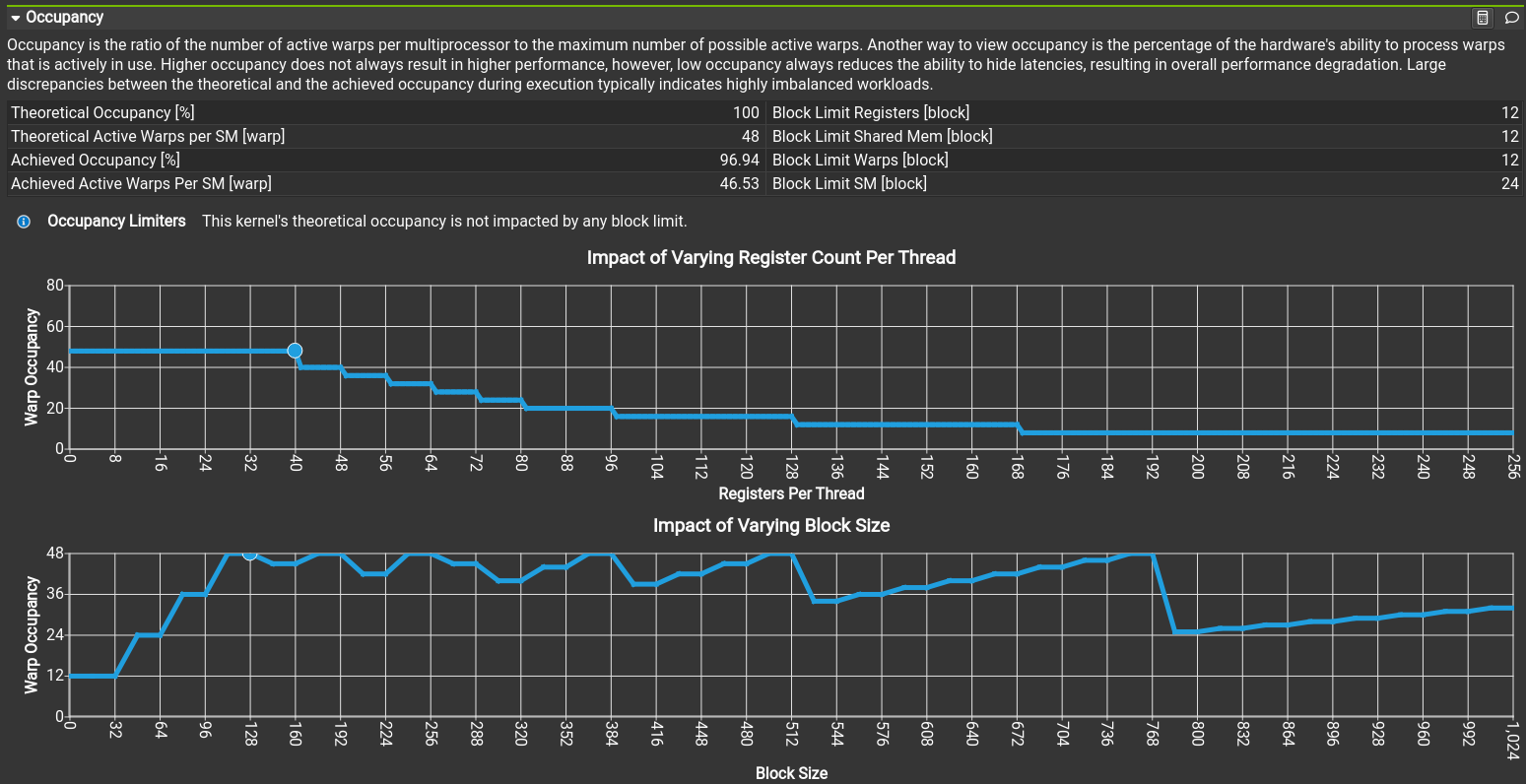
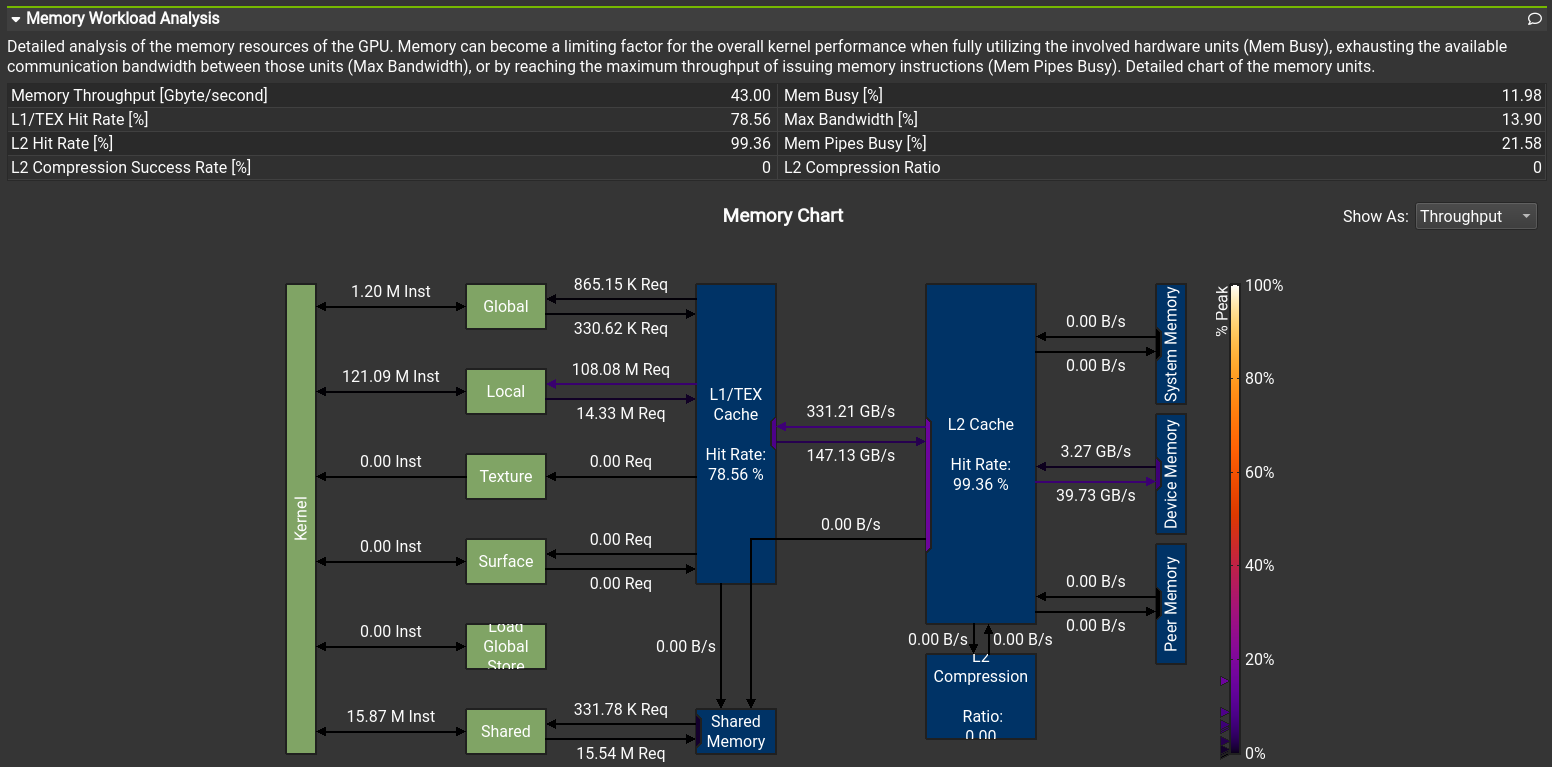
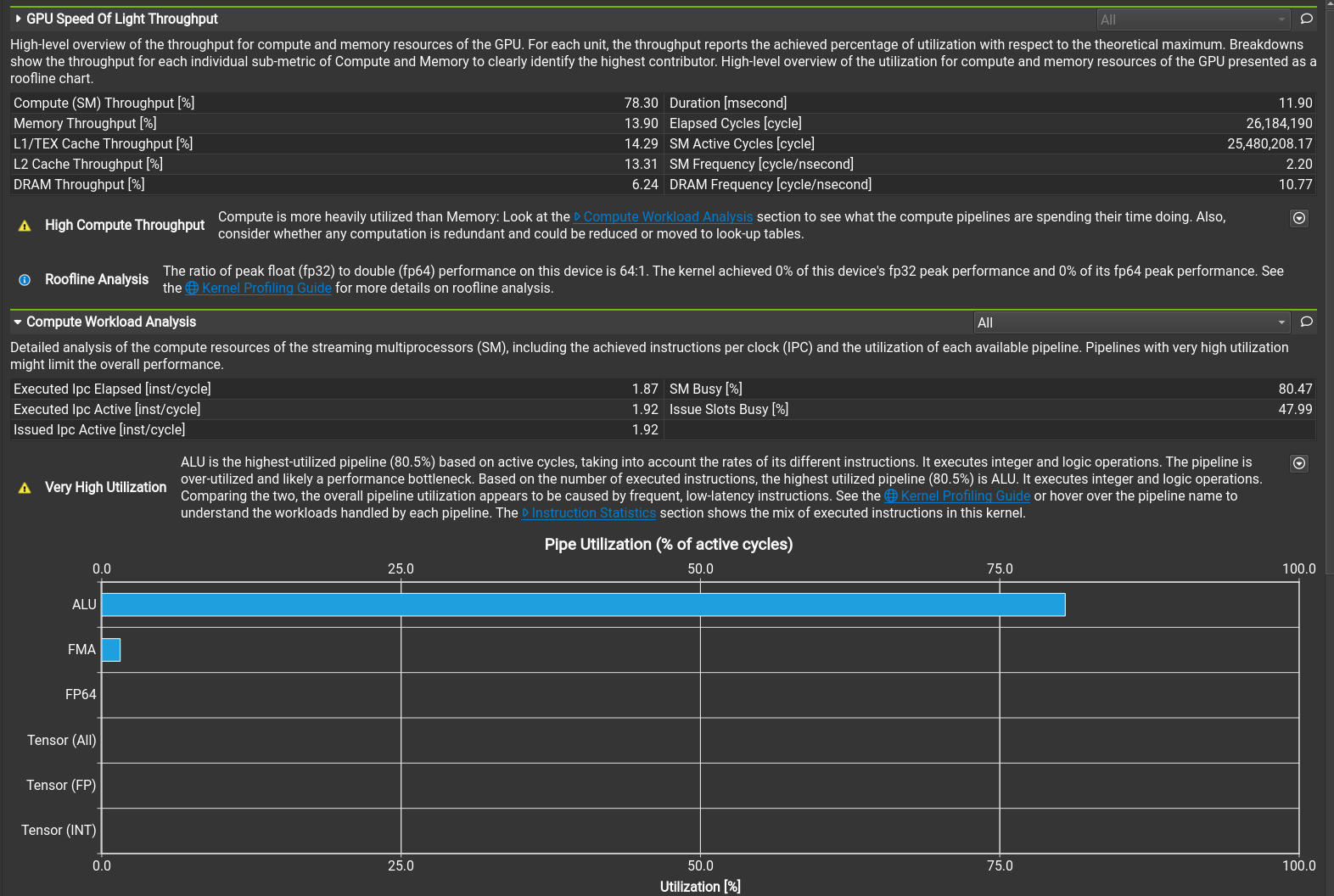
When four large numbers are used, each set of six numbers is unique from all other sets of four large numbers. But this isn't the case of other options, for example choosing two random numbers from sets "14, 13, 12, 11" and "15, 14, 13, 12" both contain the set "14, 12". We can save lots of time by calculating only distinct games of six numbers. This gives us the following results:
- One large, 0.13 million rows: Zipped CSV, Parquet
- Two large, 2.46 million rows: Zipped CSV, Parquet
- Three large, 65.10 million rows: Zipped CSV, Parquet
- Four large, 140.53 million rows: Zipped CSV, Parquet
Here the most difficult games are shown for one, two, three and four large numbers. To convert this into a probability, the n_solutions can be divided by 900 since the target number is between 100 and 999 (inclusive).
- # 1 large
- A B C D E F n_solutions
- 11 3 2 2 1 1 89
- 12 3 2 2 1 1 108
- 13 3 2 2 1 1 114
- 14 3 2 2 1 1 131
- 15 3 2 2 1 1 138
- 11 4 2 2 1 1 141
- 16 3 2 2 1 1 154
- 11 3 3 2 1 1 157
- 12 4 2 2 1 1 158
- 17 3 2 2 1 1 162
- # 2 large
- A B C D E F n_solutions
- 74 73 2 2 1 1 193
- 68 67 2 2 1 1 194
- 86 85 2 2 1 1 195
- 71 70 2 2 1 1 198
- 89 88 2 2 1 1 199
- 80 79 2 2 1 1 200
- 92 91 2 2 1 1 200
- 83 82 2 2 1 1 200
- 77 76 2 2 1 1 201
- 95 94 2 2 1 1 201
- # 3 large
- A B C D E F n_solutions
- 67 66 65 2 1 1 116
- 67 66 65 2 1 1 116
- 67 66 65 2 1 1 116
- 67 66 65 2 1 1 116
- 59 58 57 2 1 1 117
- 59 58 57 2 1 1 117
- 59 58 57 2 1 1 117
- 59 58 57 2 1 1 117
- 65 64 63 2 1 1 118
- 65 64 63 2 1 1 118
- # 4 large
- A B C D E F n_solutions
- 97 50 49 48 1 1 82
- 96 49 48 47 1 1 82
- 95 49 48 47 1 1 84
- 99 51 50 49 1 1 84
- 93 48 47 46 1 1 85
- 99 50 49 48 1 1 85
- 92 47 46 45 1 1 86
- 98 50 49 48 1 1 86
- 100 51 50 49 1 1 86
- 95 48 47 46 1 1 87
Out of curiosity, an alternative version of the kernel was also implemented. Rather than only indicating which numbers are reachable by one, two, three, four or file binary operations, these are reported individually. These don't take into account that the target number 100 can be already in the game set.
- Four large, 140.53 million rows: Zipped CSV, Parquet
Games with smallest and largest number of reachable targets in exactly three binary operations are listed below. Apparently it is impossible to reach all 900 targets in this case, when four large numbers are used.
- A B C D E F n1 n2 n3 n4 n5 n_all
- 49 48 47 25 1 1 0 4 16 70 151 160
- 48 47 46 45 1 1 0 4 18 51 110 112
- 92 47 46 45 1 1 3 8 19 52 79 86
- 68 35 34 33 1 1 3 8 19 60 107 115
- 50 49 48 25 1 1 0 5 20 60 121 124
- ...
- 34 28 25 21 10 2 10 164 738 899 900 900
- 34 28 25 19 10 2 10 160 740 898 900 900
- 37 26 23 19 10 2 10 172 740 897 900 900
- 35 27 24 21 10 2 10 159 741 899 900 900
- 34 28 27 21 10 2 10 163 752 900 899 900
Statistics of these results are plotted in figures 4 - 6. They show percentile plots and frequency plots. Interestingly the shape of n2 and n3 is similar at Figure 5, except their x-axis ranges are different. Also n5 and n_all are very similar, which means that using 1 - 4 operations doesn't bring that many new reachable targets. Further patterns and correlations could be studied on this dataset, but that isn't the focus of this article.
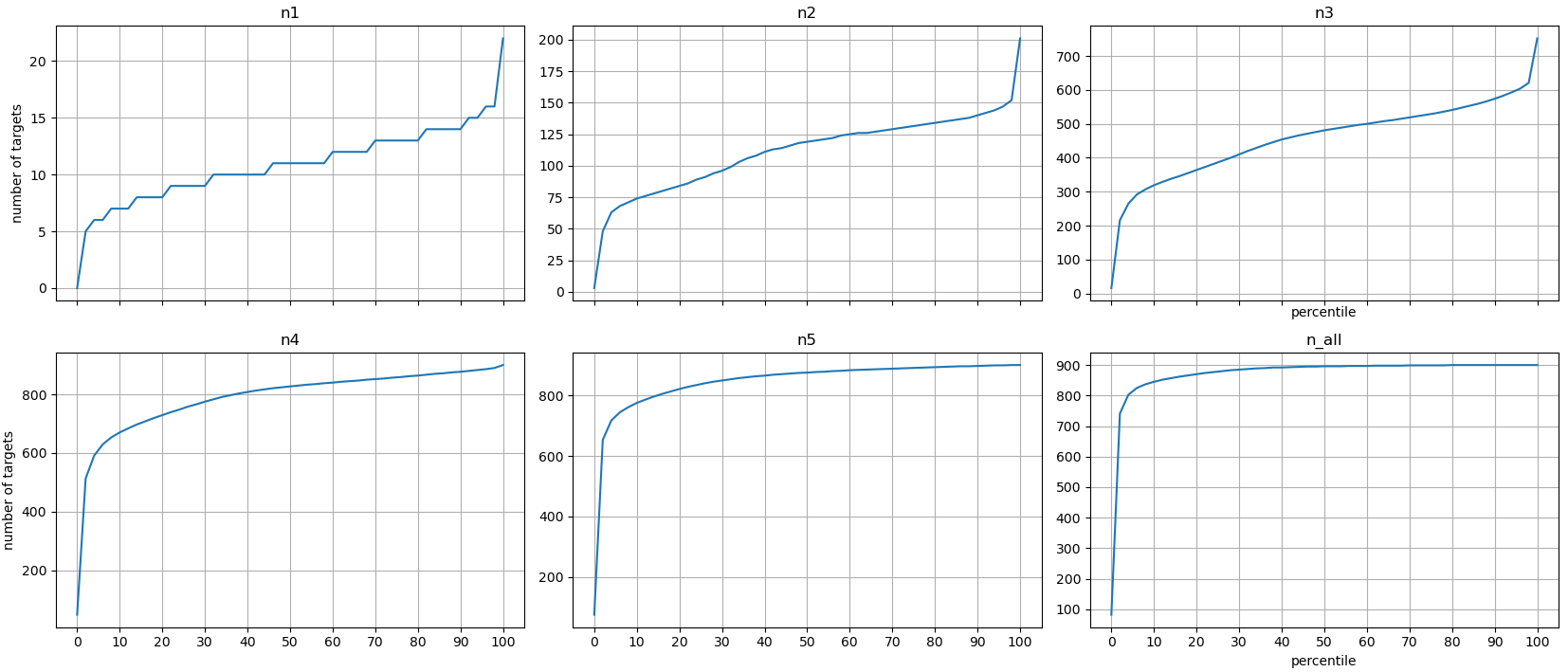
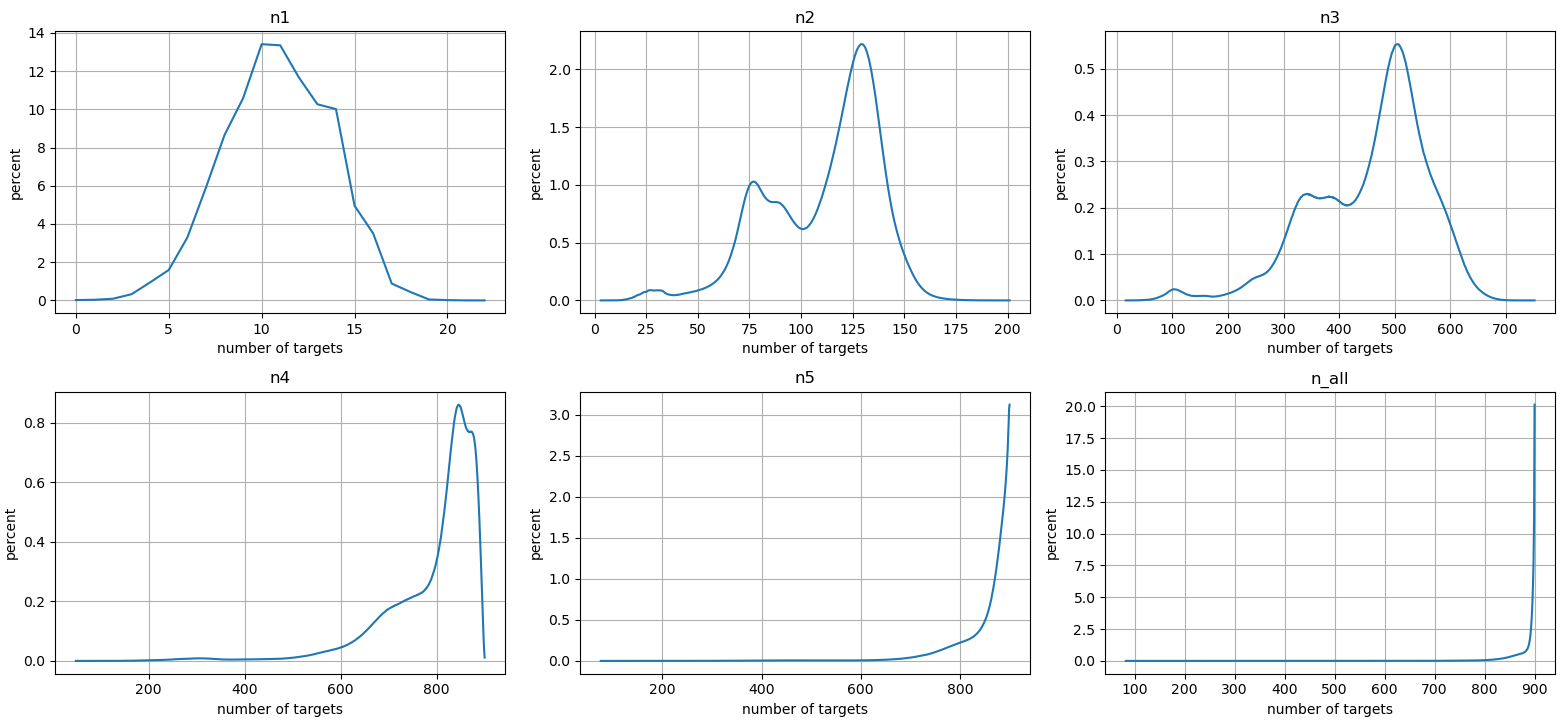
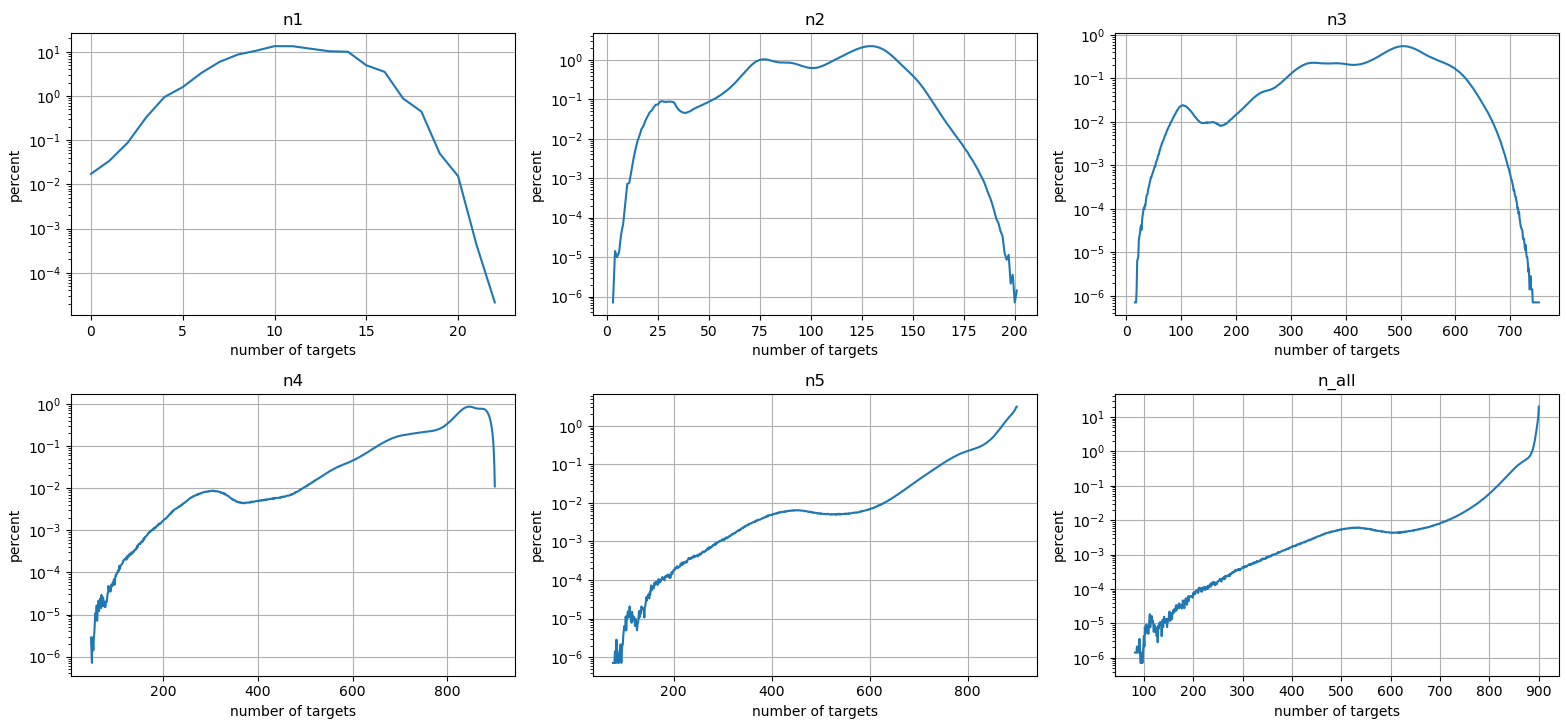
The final step is to aggregate the results from individual games together. Since there are 2.56 million distinct sets of four numbers, all of these dataframes have exactly that many rows. A separate script was used to merge correct results from individual games to each sets of large numbers.
One caveat is that what distribution of small numbers we are using? Here the supplied reference code generates correctly all possible sets, but when aggregating the results, each of them had implicitly an uniform probability. Discrepency between these distributions was confirmed by a simple simulation. These are for one large number, so five small ones are picked:- a = np.array(BuildSets1Large([100,99,98,97]))
- a = a[:,1:] # Strip the large number
- c1 = collections.Counter(tuple(sorted(np.unique(a[i],return_counts=True)[1]))
- for i in range(a.shape[0]))
- [(k, c1[k] / sum(c1.values())) for k in sorted(c1.keys())]
- # ->
- [((1, 1, 1, 1, 1), 0.17355),
- ((1, 1, 1, 2), 0.57851),
- ((1, 2, 2), 0.24793)]
- # Two cards of each small number, pick five without replacement
- small = np.repeat(np.arange(1, 11), 2)
- b = np.vstack([np.random.choice(small, replace=False, size=5)
- for _ in range(int(1e5))])
- c2 = collections.Counter(tuple(sorted(np.unique(b[i], return_counts=True)[1]))
- for i in range(b.shape[0]))
- [(k, c2[k] / sum(c2.values())) for k in sorted(c2.keys())]
- # ->
- [((1, 1, 1, 1, 1), 0.52008),
- ((1, 1, 1, 2), 0.43363),
- ((1, 2, 2), 0.04629)]
- One large, 2.56 million rows: Zipped CSV
- Two large, 2.56 million rows: Zipped CSV
- Three large, 2.56 million rows Zipped CSV
- Four large, 2.56 million rows Zipped CSV
The following very large ASCII table lists easiest 10 and hardest 10 sets of four large digits, for game variants with one, two, three or four large numbers picked. Hopefully this isn't too confusing. The probability is approximate, the accurate fraction can be calculated from n_sum and the number of distinct small numbers. For example on the top row 4686705 / (5808 * 900) = 0.8965995179063361. Apparently the only 100% winning strategy is to pick a suitable set of four large numbers (4.44% of all possibilities), take all of them into the game and have any two random small numbers. Then any target number is reachable with 100% probability.
- # 1 large, 5808 distinct small numbers
- A B C D n_min n_median n_max n_sum prob
- 16 14 12 11 89 847 900 4686705 0.896600
- 16 15 12 11 89 846 900 4688817 0.897004
- 15 14 12 11 89 846 900 4689055 0.897049
- 18 16 12 11 89 847 900 4689284 0.897093
- 18 14 12 11 89 847 900 4689522 0.897138
- 18 15 12 11 89 847 900 4691634 0.897542
- 20 16 12 11 89 846 900 4692095 0.897631
- 20 14 12 11 89 846 900 4692333 0.897676
- 20 15 12 11 89 845 900 4694445 0.898080
- 20 18 12 11 89 846 900 4694912 0.898170
- ...
- 97 95 93 83 393 894 900 5078791 0.971608
- 97 94 93 83 395 894 900 5078173 0.971490
- 97 95 94 93 393 894 900 5078041 0.971465
- 97 93 87 83 395 894 900 5077498 0.971361
- 97 93 89 83 392 894 900 5077419 0.971346
- 97 95 93 87 393 894 900 5077366 0.971336
- 97 95 93 89 392 894 900 5077287 0.971321
- 97 93 91 83 353 894 900 5076949 0.971256
- 97 95 93 91 353 894 900 5076817 0.971231
- 97 94 93 87 395 894 900 5076748 0.971217
- # 2 large, 3690 distinct small numbers
- A B C D n_min n_median n_max n_sum prob
- 24 18 16 12 473 864 900 3091209 0.930807
- 24 20 16 12 478 864 900 3093851 0.931602
- 20 18 16 12 473 867 900 3100951 0.933740
- 24 16 14 12 478 867 900 3104829 0.934908
- 24 20 18 12 508 867 900 3106884 0.935527
- 20 16 14 12 501 869 900 3108878 0.936127
- 24 16 15 12 462 869 900 3110461 0.936604
- 18 16 14 12 473 870 900 3112476 0.937210
- 24 18 14 12 502 869 900 3113607 0.937551
- 32 24 16 12 478 870 900 3114634 0.937860
- ...
- 97 75 62 13 430 899 900 3281410 0.988079
- 98 75 61 13 424 899 900 3281395 0.988074
- 97 74 61 13 421 899 900 3281379 0.988070
- 97 75 58 13 428 899 900 3281272 0.988037
- 33 29 26 23 483 899 900 3281217 0.988021
- 97 75 61 13 424 899 900 3281050 0.987970
- 88 75 61 13 424 899 900 3281037 0.987967
- 93 68 55 13 417 898 900 3280971 0.987947
- 97 74 59 13 400 899 900 3280954 0.987942
- 87 74 61 13 421 899 900 3280929 0.987934
- # 3 large, 840 distinct small numbers
- A B C D n_min n_median n_max n_sum prob
- 80 64 48 32 403 835 897 683959 0.904708
- 96 64 48 32 290 840 900 687770 0.909749
- 96 80 64 48 327 845 900 688736 0.911026
- 96 80 64 32 290 842 900 690037 0.912747
- 99 98 97 96 135 872 900 691180 0.914259
- 80 72 64 32 403 852 900 692502 0.916008
- 98 97 96 95 133 871 900 692663 0.916221
- 94 93 92 91 130 873 900 693188 0.916915
- 95 94 93 92 131 872 900 693653 0.917530
- 97 96 95 94 133 871 900 693919 0.917882
- ...
- 100 58 17 11 878 900 900 755828 0.999772
- 100 58 15 11 878 900 900 755790 0.999722
- 100 47 19 15 883 900 900 755788 0.999720
- 100 57 17 11 878 900 900 755787 0.999718
- 100 62 15 11 863 900 900 755782 0.999712
- 100 61 14 11 868 900 900 755775 0.999702
- 100 58 17 13 867 900 900 755774 0.999701
- 100 37 25 22 874 900 900 755772 0.999698
- 100 53 17 14 873 900 900 755766 0.999690
- 100 37 26 23 872 900 900 755762 0.999685
- # 4 large, 55 distinct small numbers
- A B C D n_min n_median n_max n_sum prob
- 98 97 49 48 93 804 887 40495 0.818081
- 99 98 50 49 91 806 890 40703 0.822283
- 99 98 97 49 120 819 890 41211 0.832545
- 97 96 49 48 92 822 885 41311 0.834566
- 99 98 97 96 116 831 892 41351 0.835374
- 95 94 48 47 92 823 883 41385 0.836061
- 94 93 47 46 91 828 879 41402 0.836404
- 93 92 47 46 91 835 891 41440 0.837172
- 98 50 49 48 86 828 890 41512 0.838626
- 92 91 46 45 95 835 889 41550 0.839394
- ...
- 100 99 98 97 900 900 900 49500 1.0
- 100 98 56 13 900 900 900 49500 1.0
- 100 94 56 13 900 900 900 49500 1.0
- 100 83 54 40 900 900 900 49500 1.0
- 100 95 56 13 900 900 900 49500 1.0
- 100 82 54 40 900 900 900 49500 1.0
- 100 81 54 40 900 900 900 49500 1.0
- 100 96 56 13 900 900 900 49500 1.0
- 100 80 54 40 900 900 900 49500 1.0
- 100 79 54 40 900 900 900 49500 1.0
These results are also summarized in fiugres 7 and 8. The first one uses a logarithmic x-axis for the percentile (between 0.001 and 100%), and the second one uses a logarithmic y-axis to show what percent of four large options can reach any given number of solutions. On the second one a scatter plot would have been better, since now zero values are implicitly filled in as the data points are connected by lines.
A lot more analysis could be done. For example how does the prob metric correlate between sets of one, two, three or four large numbers in the game?
- # Load and join data
- cols = ['A', 'B', 'C', 'D', 'prob']
- dfs = {i: pd.read_csv(f'BuildSets{i}Large_agg.csv')[cols]
- .rename(columns={'prob': f'prob{i}'})
- for i in [1,2,3,4]}
- df = dfs[1]
- for i in [2,3,4]:
- df = df.merge(dfs[i], on=cols[:4])
- # Extract a numpy array
- prob = df[[f'prob{i}' for i in [1,2,3,4]]].values
- np.corrcoef(prob.T).round(3)
- # ->
- array([[ 1. , 0.345, -0.508, -0.57 ],
- [ 0.345, 1. , 0.444, 0.213],
- [-0.508, 0.444, 1. , 0.903],
- [-0.57 , 0.213, 0.903, 1. ]])
So doing well in games with four large numbers do very poorly if only one large and five small numbers are chosen. If the number of large numbers is chosen at random, then we must sort the sets of four large numbers by the average probability! So we must include yet an other table of results, for easiest and most difficult options:
- A B C D prob1 prob2 prob3 prob4 prob_avg
- 80 64 48 32 0.945902 0.952221 0.904708 0.843960 0.911698
- 96 64 48 32 0.947766 0.951855 0.909749 0.857535 0.916726
- 96 80 64 48 0.954885 0.960122 0.911026 0.843556 0.917397
- 98 97 49 48 0.959690 0.965402 0.926544 0.818081 0.917429
- 90 81 45 36 0.947605 0.957966 0.924418 0.841374 0.917841
- 99 98 50 49 0.959587 0.965849 0.927534 0.822283 0.918813
- 81 54 45 36 0.944885 0.956279 0.924218 0.852808 0.919547
- 81 63 45 36 0.946209 0.960964 0.926060 0.845717 0.919738
- 81 72 45 36 0.945081 0.955929 0.925996 0.852768 0.919943
- 99 98 97 96 0.968871 0.961470 0.914259 0.835374 0.919993
- ...
- 100 93 79 67 0.967251 0.981994 0.994673 1.000000 0.985980
- 100 93 78 59 0.965477 0.983066 0.995524 1.000000 0.986017
- 100 97 83 61 0.967710 0.981558 0.994862 1.000000 0.986033
- 100 93 77 58 0.965671 0.983316 0.995153 1.000000 0.986035
- 100 93 79 59 0.966544 0.982304 0.995341 1.000000 0.986047
- 100 93 77 57 0.965633 0.983357 0.995206 1.000000 0.986049
- 100 93 77 61 0.966833 0.983481 0.993944 1.000000 0.986065
- 100 97 83 59 0.967458 0.981784 0.995116 1.000000 0.986090
- 100 93 77 53 0.965935 0.983366 0.995638 1.000000 0.986235
- 100 93 77 59 0.966582 0.983578 0.994935 1.000000 0.986274
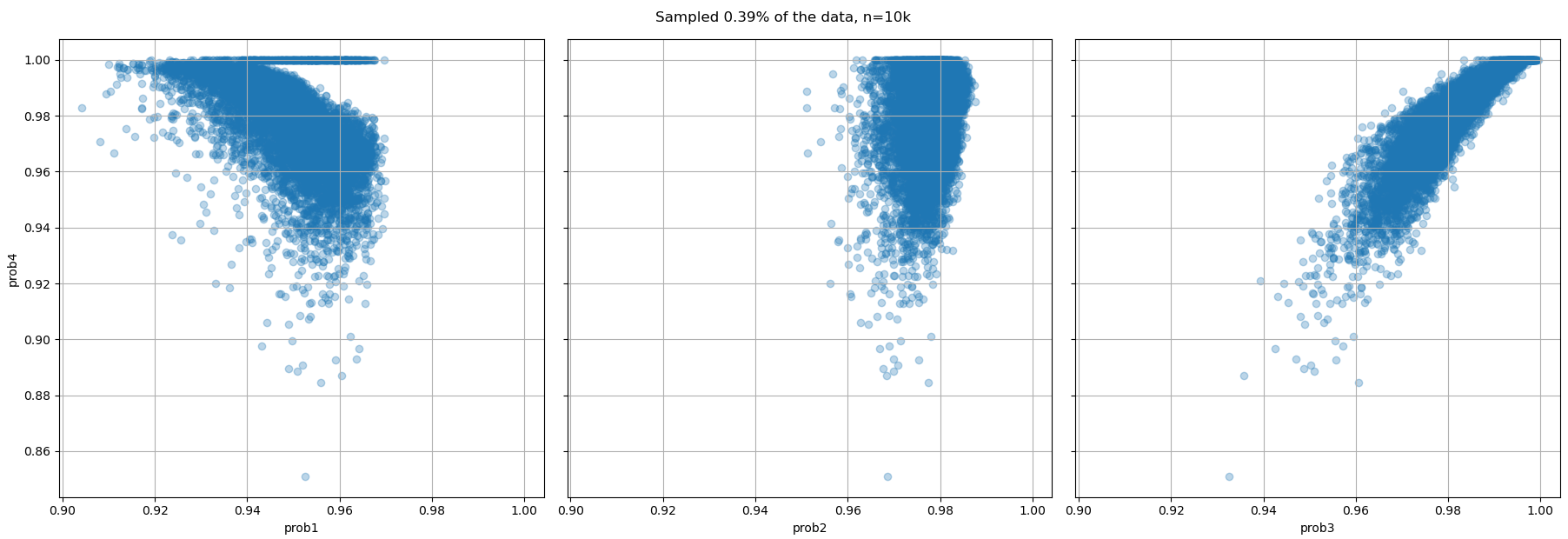
Related blog posts:
|
|
|
|
|
|
|
|
|
|


